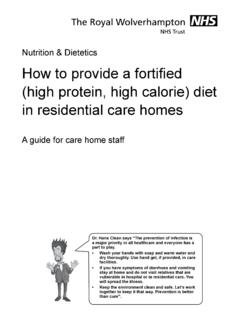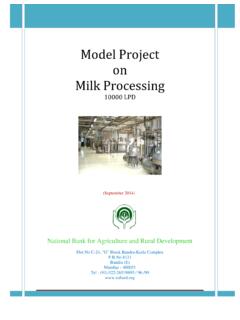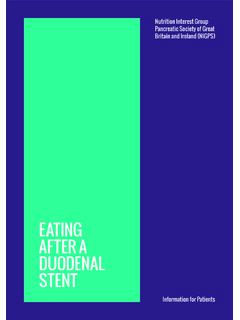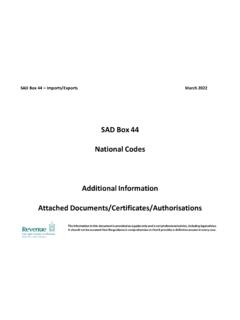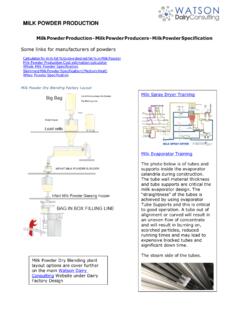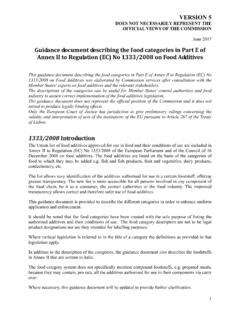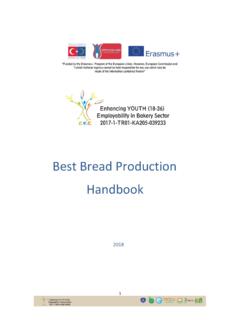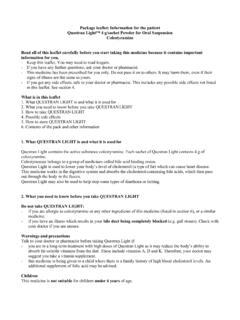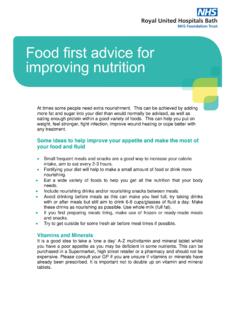Transcription of BRC Guidance on Allergen Labelling and the Requirements …
1 BRC Guidance on Allergen Labelling and the Requirements in Regulation 1169/2011In partnership with2 BRC Guidance on Allergen Labelling (EU FIC)iNTRODUCTiONRegulation (EU) No. 1169/2011 on the provision of information to consumers (EU FIC) was published on 25 October 2011. It entered into force in December 2011, leaving companies until December 2014 to comply with its provisions. In the area of allergens the Regulation introduces new Requirements . It specifically requires allergens to be highlighted in the ingredients lists. This document has been produced, by the British Retail Consortium (BRC) with support from the Food and Drink Federation (FDF), to help companies in their implementation of the provisions of the Regulation. In addition, retailers felt that the new Regulation brought an opportunity for a more consistent Allergen Labelling approach; the document reflects the approach that the majority of retailers have agreed to implement.
2 It is important to note that this document will help companies comply with the Allergen provisions in EU FIC; however this is not the only way. The European Commission and Government Departments could publish Guidance allowing a more pragmatic interpretation of the provisions of the Regulation. The Food Standards Agency very much welcomes the BRC s efforts to achieve greater consistency in Allergen Labelling and interpretation of the new provisions. This consistent approach will make it much easier for the allergic consumer to find and understand the Allergen information provided on prepacked foods and help them to make safer food choices. The Food Standards Agency BRC Guidance on Allergen Labelling (EU FIC)ALLERGY BOXES / ADViCE / STATEMENTSB ackground Feedback from the Commission has indicated that the contains.
3 (list of allergens) statements that many companies have been using as part of the allergy boxes, Allergen advice or Allergen statements on pack; will no longer be allowed, according to the provisions in EU Regulation No. 1169/2011 (EU FIC). Consumer research has suggested that consumers, who have been relying on these allergy boxes or statements to obtain Allergen information, are likely to overlook the information provided in the ingredients list. Voluntary adviceTherefore, we advise that companies who have been using an allergy advice or Allergen statement on pack, prior to the publication of EU FIC, continue to use these. However the contains .. (list of allergens) statement will be replaced by one of the following phrases: Allergy Advice For allergens, including cereals containing gluten, see ingredients in bold Allergy Advice For allergens, see ingredients in bold The reference to bold in the phrases will be replaced with the highlighting option chosen by each company.
4 Each company will maintain the format for the allergy box or allergy statement they were previously using for this information on their first phrase, which makes reference to allergens including cereals containing gluten, will be used in products containing a cereal containing gluten in their composition. For products which do not contain a gluten containing cereal as an ingredient, the second phrase will be used. This phrase should be followed by the following potential cross contamination statement. With the purpose to avoid consumer confusion, the word also will be used in this phrase: Example: Also, not suitable for customers with peanut allergy Also, may contain soya and egg May also contains nuts BRC Guidance on Allergen Labelling (EU FIC)Exemption: The word also will be removed when the product contains no deliberate allergens and therefore the first statement is not used.
5 The Allergen in the cross contamination statement will not be highlighted in bold (or the company s chosen method of highlighting). See below for in the allergy boxes, Allergen advice or statements is to be given in a font size, at least as big as the font used for the ingredients list. ExamplesINGREDIENTS: Wheat flour, dried onions, palm oil, dried parsley, skimmed milk powder Allergy Advice!For allergens, including cereals containing gluten, see ingredients in bold Also, not suitable for customers with peanut allergyIngredientsOatmeal Bread (51%) (Wheat Flour, Water, Oatmeal, Wheat Bran, Yeast, Salt, Spirit Vinegar, Wheat Protein, Emulsifiers (Mono- and diglycerides of fatty acids - Vegetable, Mono- and diacetyl tartaric acid esters of mono- and diglycerides of fatty acids - Vegetable), Vegetable Oil (Rapeseed, Palm), Malted Barley Flour, Flour Treatment Agent (Ascorbic acid), Soft Cheese* (25%) ( milk ) (contains salt), Scottish Farmed Smoked Salmon (Fish) (contains Sea Salt, Demerara Sugar), Single Cream ( milk ))
6 , Lemon Juice, Black AdviceFor allergens, including cereals containing gluten, see ingredients in bold May also contain egg, soyaSunflower oil, water, white wine vinegar, sugar, pasteurised free range egg yolk, Parmigiano Reggiano cheese (4%) ( milk ), salt, extra virgin olive oil (1%), concentrated lemon juice, dried onion, Worcester sauce, garlic pur e, black pepper, onion pur e, anchovy paste, stabiliser xanthan gum, citric acidWorcester sauce contains water, spirit vinegar, barley malt vinegar, sugar, molasses, salt, onion powder, garlic powder, tamarind extract, ginger powder, chilli powderAnchovy paste contains anchovy (fish), salt, olive oil, spirit vinegarFor allergens see ingredients in boldINGREDIENTSALLERGENS BRC Guidance on Allergen Labelling (EU FIC)iNGREDiENT LiST Background The EU FIC requires substances and products causing allergies or intolerances to be indicated in the list of ingredients, with a clear reference to the name of the substance or product causing the allergy on intolerance.
7 These substances are listed in Annex II of the EU FIC. The substances or products causing allergies should be emphasised through a typeset that clearly distinguishes it from the rest of the list of ingredients, for example by means of the font style or background colour. 1. Highlighting methodThe preferred option is bold. However companies may use other ways of highlighting the allergens in the ingredients list, as this is not specified in the NutsThe named nuts in Annex II of the Regulation will be listed by their specific name in the ingredients list. No reference to the word nuts will be included between brackets after the named nuts. Exemption: pecans and macadamias will be declared as pecan nuts and macadamia nuts. For these nuts, both words pecan and nuts should be in bold, for consistency with nuts such as : The word nuts can be used in the cross contamination statement, instead of referring to each one of the nuts potentially present.
8 Examples: Also may contain nuts, or Also may contain almonds, brazil nuts and hazelnuts.. Fish Fish will be declared in brackets straight after every fish, even common species such as salmon, cod or mackerel. Exemption: Fish species like swordfish can be declared as swordfish or swordfish (fish) Companies may want to use the statement contains fish in fish sold as such, especially if the product name does not contain the word fish. Example: Tilapia (fish), Basa (fish) or Basa (contains fish)6 BRC Guidance on Allergen Labelling (EU FIC) . Crustaceans and molluscsThe words crustacean or mollusc will be declared in brackets straight after every crustacean and mollusc. Example: prawn (crustacean), oyster (mollusc) For a certain period of time, and with the aim of helping consumer understanding, some companies may choose to highlight the actual crustacean and mollusc in addition to the words crustacean and mollusc.
9 Example: prawn (crustacean)Companies may want to use the statement contains crustaceans or contains molluscs in products sold as such. Example: In a pack of mussels, the following statement could be used contains molluscs . MilkFor all ingredients containing or derived from milk , milk will be declared in brackets straight after the ingredient. Example: Lactose ( milk ) However, where the ingredient name contains the word milk , it will be highlighted in the name of that ingredient and not repeated in brackets. Example: Dried skimmed milk milk will be declared after ingredients such as cream, yogurt, cheese and butter, despite consumers understanding that these products contain milk . Example: Curry SauceCompanies may want to use the statement Contains milk in cream, yogurt, cheese and butter sold as such (these products will not have an ingredients list).
10 INGREDIENTS: Water, Low Fat Greek Style Natural Yoghurt ( milk ), Mayonnaise (Water, Rapeseed Oil, Spirit Vinegar, Sugar, Potato Starch, Corn Starch, Pasteurised Egg Yolk, Salt, Lemon Juice), Mango Chutney (Sugar, Mango, Salt, Vinegar, Cloves, Cinnamon, Water, Acetic Acid, Spices), Curry Paste (Water, Vegetable Oil, Garlic, Concentrated Tomato Puree, Coriander, Ginger, Onion Powder, Turmeric, Sugar, Paprika, Cumin, Corn Starch, Chilli Powder, Acetic Acid, Lemon Juice, Fennel, Chilli, Fenugreek, Pepper, Lactic Acid, Mixed Spices), Coriander, Salt BRC Guidance on Allergen Labelling (EU FIC)6. Cereals containing GlutenCereals containing gluten will be declared in the ingredients list using the specific name of the cereal, wheat, rye, barley, oats, spelt or kamut. Example: wheat flour, oats, malted barley flour.


